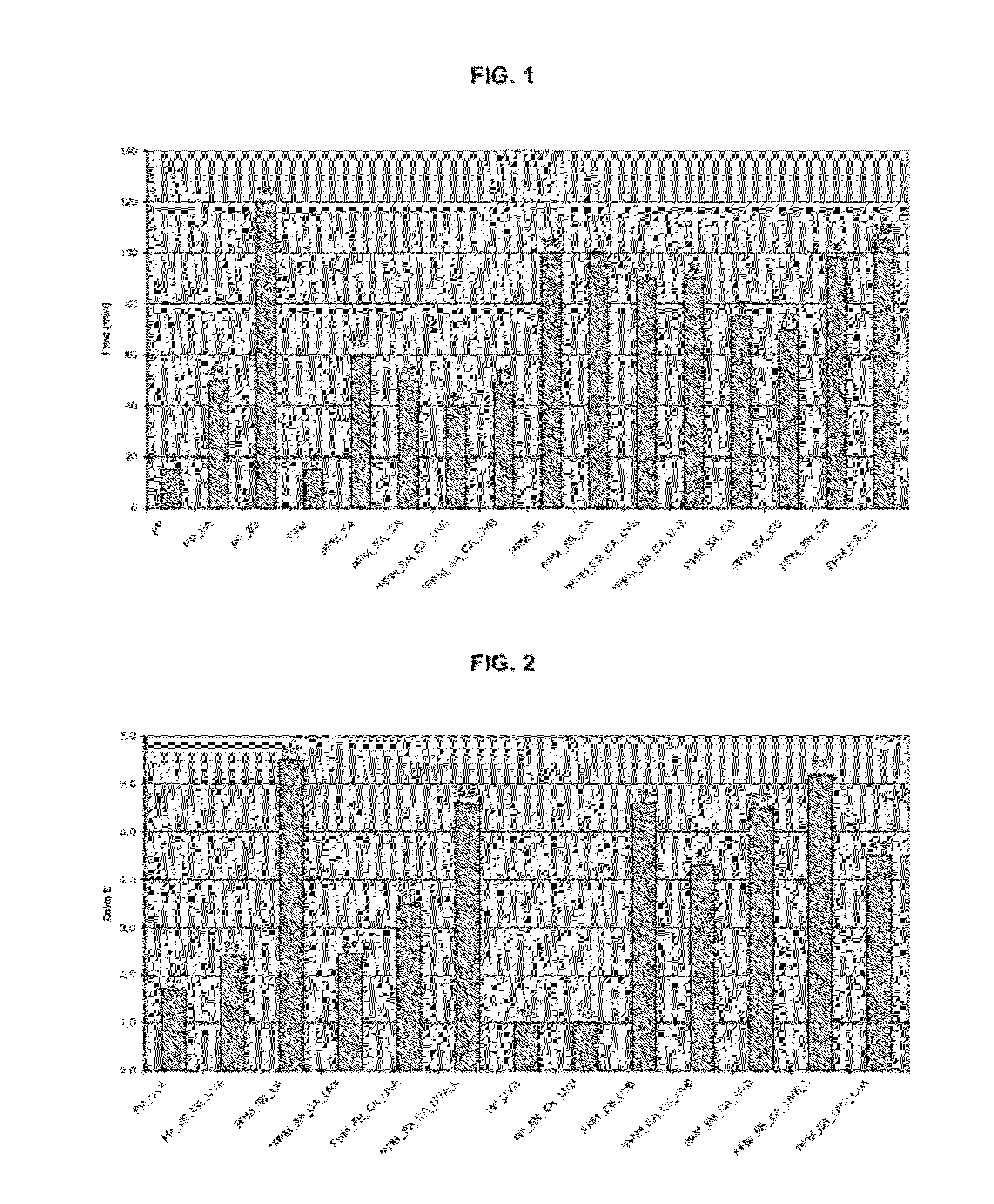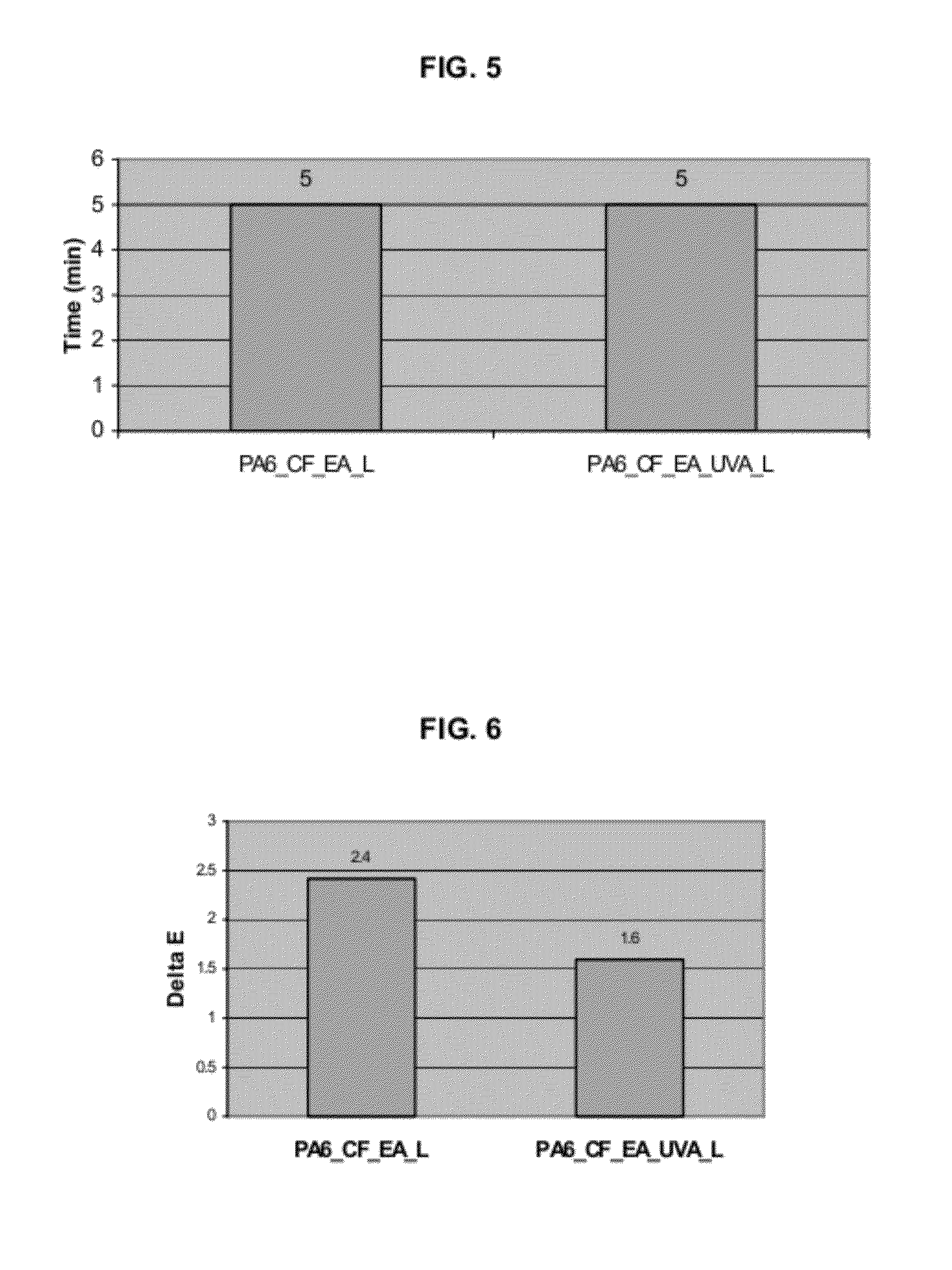Wood-plastic composite with improved thermal and weathering resistance and method of making the same
a technology of wood-plastic composites, which is applied in the field of thermoplastic compositions containing natural fillers, can solve the problems of relatively low degradation temperature of cellulose, hygroscopic nature of wood, and plastic composite processors, and achieve the effects of improving thermal and weathering resistance, reducing the problem of thermal degradation of cellulose during processing, and reinforcement fillers and/or wood aesthetics
- Summary
- Abstract
- Description
- Claims
- Application Information
AI Technical Summary
Benefits of technology
Problems solved by technology
Method used
Image
Examples
example 1
[0052]The formulations for the Example 1 were prepared from the components listed in Table 1 below.
[0053]The manufacturing process of compositions having enhanced thermal resistance and UV resistance was performed as follows. Preparation of the wood plastic polyolefin-based composite was performed using a polypropylene copolymer (PPco) with woodflour, compatibilizers, lubricants, thermal and UV stabilizers. The formulations used in these examples used components and their amounts as described on Table 1. It should be noted that the amount of the polypropylene and wood flour varied based on whether any given sample included wood flour or not. In those embodiments wherein only polypropylene was used, the compositions included 100 parts (or 100 wt % exclusive of any additives) and in embodiments including wood flour, the compositions included 70 parts polypropylene and 30 parts wood flour (again totalling 100 wt % exclusive of any additives). The amount(s) of thermal stabilizer, UV sta...
example 2
[0066]The formulations for the Example 2 were prepared from the components listed in Table 6 below.
[0067]The manufacturing process of compositions having enhanced thermal resistance and UV resistance was performed as follows. Preparation of the wood plastic polyolefin-based composite was performed using a polypropylene copolymer (PPco) with vegetalfiber, thermal and UV stabilizers. The formulations used in this example, including the components and their amounts, are described in Table 6.
TABLE 6ComponentsConcentration(parts)ProductPolypropylene70-100Polypropylene copolymerCopolymerMelt Flow Index 25 g / 10 minThermal0.3Antioxidant blend systems containing 1,3,5-Tris(4-tert-Stabilizersbutyl-3-hidroxy-2,6-dimethyl benzyl)-1,3,5-triazine-(1H,3H,% H)-trione and Tris (2,4-di-t-butylphenyl)phosphiteUV Stabilizers0.8UV stabilizers UVA + HALS blends and high molecularweight blend based on synergistic combination of tertiaryand secondary amines.Compatibilizer3.0Maleic Anhydride Grafted Polypro...
example 3
[0076]The formulations for the Example 3 were prepared from the components listed in Table 10 below.
[0077]The manufacturing process of compositions having enhanced thermal resistance and UV resistance was performed as follows. Preparation of the wood-plastic polyamide-based composite was performed using a Polyamide 6, a vegetal fiber, black masterbatch, thermal and UV stabilizers. The formulations used in this example, including the components and their amounts, are described in Table 10.
TABLE 10ComponentsConcentration(parts)ProductPolyamide 670-100Polyamide 6Thermal0.6Blends of low volatility and high resistant to hydrolysisStabilizersorganophosphites and hindered phenolic antioxidantsLubricants1.0Modified fatty acid ester(L)UV Stabilizers1.1UV stabilizers UVA + HALS blends and high molecularweight blend based on synergistic combination of tertiaryand secondary amines.Vegetalfiber0-30Curauá fiber (Ananás erectofolius of the species L.B. Smith)(0.1-15 mm length)
[0078]The chemical co...
PUM
| Property | Measurement | Unit |
|---|---|---|
| wt % | aaaaa | aaaaa |
| wt % | aaaaa | aaaaa |
| wt % | aaaaa | aaaaa |
Abstract
Description
Claims
Application Information
 Login to View More
Login to View More - R&D
- Intellectual Property
- Life Sciences
- Materials
- Tech Scout
- Unparalleled Data Quality
- Higher Quality Content
- 60% Fewer Hallucinations
Browse by: Latest US Patents, China's latest patents, Technical Efficacy Thesaurus, Application Domain, Technology Topic, Popular Technical Reports.
© 2025 PatSnap. All rights reserved.Legal|Privacy policy|Modern Slavery Act Transparency Statement|Sitemap|About US| Contact US: help@patsnap.com



